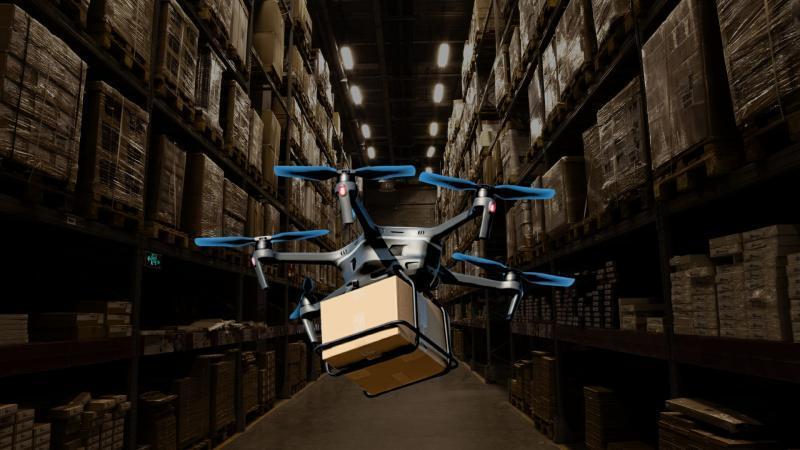
New Tech Optimises Drone Fleets for Faster, Greener Deliveries
The rise of drone technology has revolutionized the logistics industry, offering a promising solution for last-mile delivery. However, as drone fleets expand, a critical challenge has emerged: the Drone Warehouse Problem. This issue revolves around efficiently managing varied drone fleets, ensuring timely delivery of packages while minimizing environmental impact. Researchers have recently developed a novel algorithm to tackle this problem, promising faster, greener deliveries.
The Drone Warehouse Problem
As the demand for drone delivery services grows, warehouses are facing a logistical nightmare. With multiple drone models, varying capacities, and distinct flight characteristics, managing a fleet of drones becomes a complex task. The Drone Warehouse Problem is multifaceted, involving:
- Scheduling conflicts: Coordinating flight schedules to avoid collisions, minimize downtime, and optimize route planning.
- Drone capacity: Ensuring the right drone is assigned to the right package, considering factors like weight, size, and fragility.
- Weather and environmental factors: Adapting to changing weather conditions, such as wind, rain, or sunlight, to ensure safe and efficient flights.
- Package routing: Optimizing delivery routes to reduce fuel consumption, minimize traffic congestion, and increase delivery speed.
The Challenges of Traditional Methods
Traditional methods for managing drone fleets rely on manual scheduling, which can lead to inefficiencies and increased costs. Human operators must manually allocate drones, taking into account various factors, including weather conditions, traffic, and drone capacity. This approach can result in:
- Increased labor costs: Human operators require training and expertise, increasing labor costs.
- Delays and errors: Manual scheduling can lead to mistakes, causing delays and missed deliveries.
- Inefficient resource allocation: Drones may not be utilized to their full capacity, resulting in wasted resources.
The Novel Algorithm
Researchers have developed a novel algorithm to tackle the Drone Warehouse Problem, optimizing drone delivery schedules and ensuring faster, greener deliveries. This algorithm, designed specifically for drone fleets, takes into account the unique characteristics of each drone, including its capacity, speed, and maneuverability.
The algorithm works by:
- Predicting demand: Analyzing historical data to predict demand and optimize drone allocation.
- Scheduling drones: Coordinating drone flight schedules to avoid conflicts, minimize downtime, and optimize route planning.
- Assigning drones: Matching drones with packages based on capacity, weight, and size.
- Adapting to weather and environmental factors: Adjusting flight plans to accommodate changing weather conditions and environmental factors.
The Benefits of Optimized Drone Fleets
The novel algorithm offers numerous benefits for warehouse operators and customers alike:
- Faster delivery times: Optimized drone schedules ensure packages are delivered quickly and efficiently.
- Reduced costs: Automated scheduling reduces labor costs and minimizes the risk of errors.
- Increased capacity: By maximizing drone utilization, warehouses can handle more packages without increasing infrastructure costs.
- Environmental benefits: Optimized drone flights reduce fuel consumption, minimize traffic congestion, and decrease carbon emissions.
- Improved customer satisfaction: Faster delivery times and increased reliability lead to higher customer satisfaction rates.
The Future of Drone Delivery
The novel algorithm is a significant step towards scalable, sustainable last-mile delivery solutions. As the demand for drone delivery services continues to grow, optimized drone fleets will play a crucial role in meeting this demand. With the ability to manage varied drone fleets efficiently, warehouses can:
- Scale operations: Expand their drone delivery services to meet growing demand.
- Improve customer experience: Offer faster, more reliable delivery options to customers.
- Reduce environmental impact: Minimize the carbon footprint of last-mile delivery.
Conclusion
The Drone Warehouse Problem is a critical challenge facing the logistics industry, but researchers have taken a significant step towards solving it. The novel algorithm optimizes drone delivery schedules, ensuring faster, greener deliveries. As the demand for drone delivery services continues to grow, optimized drone fleets will be essential for meeting this demand while minimizing environmental impact.
Source: https://researchmatters.in/news/novel-algorithm-tackles-drone-warehouse-problem-faster-deliveries






